#aboriginal landscape
Explore tagged Tumblr posts
Text

Budj Bim Cultural Landscape, Victoria, Australia: The Budj Bim Cultural Landscape is located in the traditional Country of the Gunditjmara Aboriginal people in south-eastern Australia. The three serial components of the property contain one of the world's most extensive and oldest aquaculture systems... Budj Bim, also known as Mount Eccles, is a dormant volcano near Macarthur in southwestern Victoria, Australia. It lies within the geologically-defined area known as the Newer Volcanics Province, which is the youngest volcanic area in Australia and stretches from western Victoria to south-eastern South Australia. Wikipedia
#Budj Bim Cultural Landscape#Budj Bim#Youngest volcanic area#Aboriginal cultural#UNESCO World Heritage#Newer Volcanics Province#Victoria#Australia#oceania#oceania continent
108 notes
·
View notes
Text
the day i finally gain the courage to add more australians to this blog it’s OVER for the rest of y’all 🗣️🗣️
#shakes my fist……. why i oughta#our native wildlife and landscapes are all so unique and so precious to me#it’s been a novelty introducing my partner (who is german) to australian birds and spotting them while out on walks#i’m also remembering the vague lore i came up with for a short film script…… teenage monster hunter in the flinders ranges#the only problem with the ideas i do have is that they are so specifically Set Here. forcing you all to stick your muses in the outback#thoughts 2 ruminate on.#i would also avoid using folklore specifically from aboriginal people bc i’m not indigenous#and those are not my stories to tell. don’t want to broach those subjects and end up being disrespectful if that makes sense?#✧ out of character.#tbd.
2 notes
·
View notes
Text

Sydney and the moon. 🇦🇺🌕
#Sydney#sydney harbour#sydney opera house#sydney harbour bridge#plein air#plein air painting#wallabies#koala#kangaroo#crocodile dundee#landscape painting#cityscape#cityscape painting#travel journal#travel journey#travel diary#travel blog#pop art#contemporary art#australia#australian open#Australian#bondi beach#walkabout#aboriginal#aboriginal australian#bush fires#tasmania#kangaroo island#adelaide
6 notes
·
View notes
Text
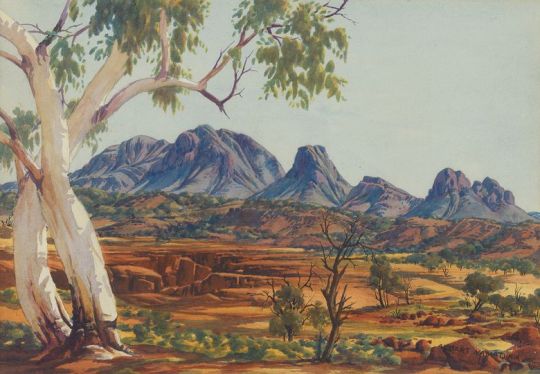
Albert Namatjira (1902–1959) famous Aboriginal artist, one of his many paintings of the Haasts Bluff country, Northern Territory.
24 notes
·
View notes
Text
We don't need to adopt all Aboriginal methods, but in this time of water, soil and farm-income crisis, it would seem a prudent management approach to consider the condition of the country at time of invasion. This condition was produced by a people who had up to 120,000 years of experience on the continent¹³ and a spirituality that always put the land first.
13. The duration of human habitation of the continent is now generally agreed to be 65,000 years, but recent research suggests that 120,000 years is probable: see Paul Daley, '"A Big Jump": People Might Have Lived in Australia Twice as Long as We Thought', The Guardian, 11 March 2019.
"Country: Future Fire, Future Farming" - Bill Gammage and Bruce Pascoe
#book quotes#country#bill gammage#bruce pascoe#nonfiction#aboriginal australian#indigenous australians#water crisis#soil crisis#farming#landscape#invasion#australia#lived experience#spirituality
0 notes
Photo



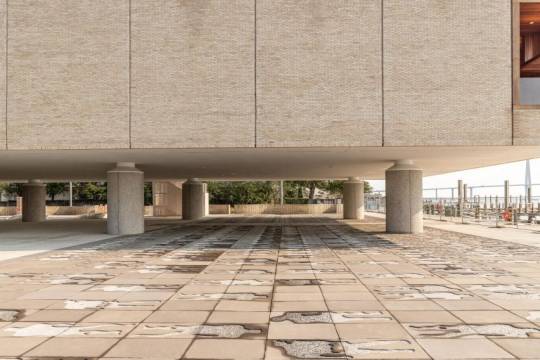


(via International African American Museum lifted above Charleston site)
0 notes
Text
Invasive Species and Xenophobia
Invasive species are complicated! People have a lot of feelings about them, positive and negative. Are plants that move "invaders" "colonizing", "immigrants", "citizens"? What does it mean to kill species that are from somewhere else? What if that species legitimately makes a poor neighbor and causes extinctions in other, native species? This complex, culturally-loaded issue is a foundational issue behind a lot of plant conservation and restoration.
This is a juicy and still actively disputed topic! The Guardian recently had a big article on colonialism in Botany, (tbh her views are dated and reductive, imo) and it’s come up again this week, to much hostility (cw: reddit). Yes, my region's native plant restoration came from literal nazis, but also, the impacts of some invasive species are real, not figments of a racist imagination. How do we balance these issues? What does ethical invasive management look like?
Since it’s such a juicy topic, I wanted to offer a few fun readings to share:
The Native Plant Enthusiasm: Ecological Panacea or Xenophobia?, Gert Gröning and Joachim Wolschke-Bulmahn, 2004, Arnoldia.
THE CLASSIC 20th century German nazis and native plants paper. Made a huge splash when it came out, and you will still encounter people who paint all native plant stuff with this brush. Summary: yeah the nazis loved their native plants and used them as part of their conquering process. Also, the first prairie plantings ever, located in Chicago, were done by a racist probable-nazi for racist reasons, full stop. I’ll let him speak for himself: “The gardens that I created myself shall… be in harmony with their landscape environment and the racial characteristics of its inhabitants. They shall express the spirit of America and therefore shall be free of foreign character as far as possible… the Latin and the Oriental crept and creeps more and more over our land, coming from the South, which is settled by Latin people, and also from other centers of mixed masses of immigrants. The Germanic character of our race, of our cities and settlements was overgrown by foreign character. The Latin spirit has spoiled a lot and still spoils things every day.” - Jens Jensen
Botanical decolonization: rethinking native plants, Tomaz Mastnak, 2014, Environment and Planning D: Society and Space
Rather than viewing native plant plantings as an act of racially-pure occupation, Mastnak positions native plants in California as a decolonization of the sub/urban lawn. Uses a lot of quotations from 16th century English philosopher Francis Bacon, and is heavy on the philosophical musings.
From killing lists to healthy country: Aboriginal approaches to weed control in the Kimberley, Western Australia by Bach et al., 2019, Journal of Environmental Management.
This paper talks through some of the native vs invasive debate, and offers a different perspective on how to approach to plant invasive management based on cultural relations, rather than country of origin or behavior.
Beyond ‘Native V. Alien’: Critiques of the Native/alien Paradigm in the Anthropocene, and Their Implications, Charles R. Warren, 2021, Ethics, Policy, & Environment
DENSE but thorough, if you want to follow the entire history of the native/invasive debate, this has you covered. The most interesting stuff, in my opinion, is the discussion of invasive denialism, IE: the impasse of “You’re just being racist!” Vs “You know nothing about ecology!” I recommend the Discussion, which starts on page 13.
#invasive species#native plants#ecology#history#i had to put a reading list together for lab this week#so you get to reap the benefits#the children yearn for the mines#except its me#the research scientist yearns for the syllabi mines
645 notes
·
View notes
Text
The tropical arid lands of Australia have been the continual home to Indigenous people possibly longer than anywhere on Earth today. Far from being one of the Earth’s remaining wilderness areas, the Western Deserts of Australia are the ancestral home of a number of Aboriginal peoples, who have managed these landscapes for millennia. Indeed, the effects of removing Indigenous peoples from the landscape in the 1960s was catastrophic, resulting in uncontrolled wildfires and a degradation of the ecological qualities for which this landscape was originally valued. Unsurprisingly, the return of these lands to Indigenous traditional owners over the past two decades has seen improvements in the socioecological dynamics of the region. Indeed, some Aboriginal peoples in Australia view “wild country” (wilderness) as “sick country’”: land that has been degraded through a lack of care through use. Thus, Aboriginal notions of wilderness are antithetical to the technocratic and romantic notions of wilderness representing “pristine” and healthy ecosystems that underpin many modern-day conservation efforts. The outcome continues to be a clash of worldviews in a globalizing society where the Western epistemologies governing dominant conservation practices operate in an echo-chamber that continues to erase other ways of knowing from conservation dialogue.
Indigenous knowledge and the shackles of wilderness
1K notes
·
View notes
Text
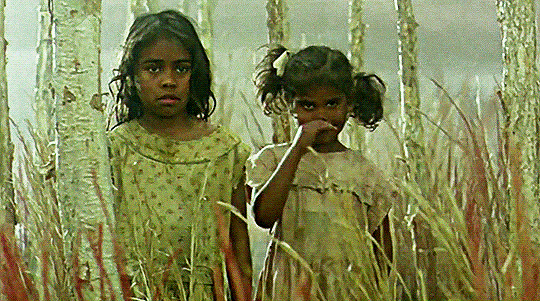


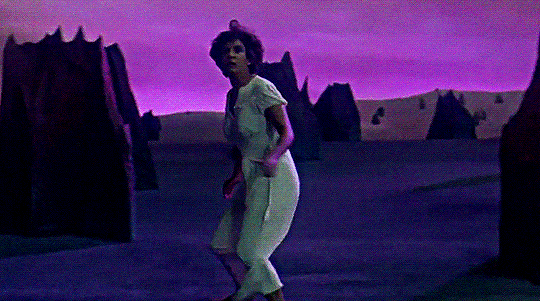





Bedevil, stylised as beDevil, is a 1993 Australian horror film directed by Tracey Moffatt, the first feature directed by an Aboriginal Australian woman.
The film is a trilogy of surreal ghost stories. Inspired by ghost stories she heard as a child from both her extended Aboriginal and Irish Australian families, Moffatt created a trilogy in which characters are haunted by the past. All three stories are set in Moffatt's highly stylised, hyper-real, hyper-imaginary Australian landscape.
BEDEVIL (1993) dir. TRACEY MOFFATT
#a favorite movie of mine that doesn't get talked about enough for my likings#my gifs#horroredit#bedevil 1993#tracey moffatt#ausfilm#ausfilmedit#indigenous cinema#aboriginal film#australian cinema#horrorfilmgifs#classichorrorblog#junkfooddaily#userbabysitter#fyeahmovies#dailyflicks#filmgifs#cinemapix#userbraindamage
1K notes
·
View notes
Text
Tags: steddie, getting together, featuring the chaotic friendship of Eddie & Dustin
🤎🌱🤎
Steve's hands are already at his hips, “Eddie, what are you doing down there?”
Eddie glances up from the hole he’d dug in the woods beyond Steve’s backyard. Looking at the dirt nearly up to his shoulders he belatedly realises that he may have become a tad fixed on his big idea.
Dappled sunlight falls through the tapestry of foliage above and the chirping of birds nearby cheerily fill the lush landscape, but none of it seems to distract Steve from his concern as he squints down at Eddie.
“Where’s Dustin?” Eddie counters like he doesn’t currently resemble a cartoon villain digging traps for the native wildlife. He resists twirling an imaginary moustache over his bare upper lip, but Steve must have an idea of his thoughts because he squints suspiciously over his arms as he folds them.
“I don’t know,” Steve says slowly from high above, “should he be here while you create what looks like your own grave?”
Eddie props his arms over the lip, tilting his chin up and aiming for charming. Playful even. “Now, why would I do that, Stevie? Life is a magnificent thing, worthy of delight and whimsy.”
“Whimsy,” Steve repeats sceptically, “like you practically digging up my backyard. You know, someone could fall and sue me, right?” Despite his scolding tone, Steve bends to kneel on the ground, his delicious thighs by Eddie’s folded hands and head hovering over his.
Eddie flutters his eyelashes as Steve waits on him, nearly close enough to kiss if he would just tilt down a fraction. “You could get in here with me, make it so there’s no room for anyone else.”
Steve’s bright hazel eyes flash and Eddie wishes he could get a handle on whether it’s because of Eddie’s suggestive tone or if it’s that Steve is simply annoyed with his antics.
Just when the silences stretches for a second too long, enough that Eddie thinks Steve might lean forward, close the gap and take Eddie’s lips in what would surely be a spectacular first kiss, he instead smirks, slyly pushing a handful of loose dirt into the hole from the high mound above Eddie’s head. It rains over Eddie’s right shoulder, which he shrugs fatalistically — he’s fairly covered at this point anyway.
“Eddie, tell me why you’ve dug a hole near as tall as you by my backyard.”
“Or what, you’ll bury me with all the other bodies out here?”
“Something like that.” Another handful rains down and Eddie sighs, “It’s a compression hole.” Steve’s hand halts, “Like the socks?”
Eddie takes the opportunity to reach out and clasp Steve’s hand, ostensibly to stop it from pushing more dirt over his shoulders but really just taking the opportunity to touch Steve. Hold the warmth of his hand within his own, stroke the silken back of it with his thumb.
Eddie steals many moments like these and Steve always lets him, but he never knows whether it's because of Steve's generous nature or if it's because he wants Eddie touching him, specifically.
“Like the socks,” he agrees, eyes sharp as Steve’s cheeks flush a faint red. Yet he retains a sceptical mien about him so Eddie further explains. “Dustin has this book—”
Steve snorts, “Here we go.”
“Dustin has this book and it says that the Aboriginals from Australia have known for ages how to take care of deadly snake bites.”
“With a hole.”
Eddie is always fascinated to see the evidence of Steve’s smiles in the shine of his eyes, and he delights in being one of the few people who often brings out its brightness. “With a hole,” he agrees with a cheeky grin, happy at Steve’s amusement.
“Bit by a Red-belly then you're in the hole for x amount of days. By a King Brown then for an nth amount of days. Placed in the hole and buried up to your neck, the compression of it all works the venom safely through your system.”
He's sad to see those pretty eyes hidden from him as Steve closes them with a deep, bracing breath. “Eddie,” he begins in a warning tone, drawing his hand away, “is Dustin finding a poisonous snake to bite you with.”
“No, definitely not,” Eddie hedges but at Steve’s stern look he squirms, “because poisonous would mean that I can’t eat them?”
“Venomous then!”
Eddie thinks that maybe he’s losing his capacity to charm Steve if the ire rising in his eyes is anything to go by. He shifts uneasily on the hard dirt below him, feeling particularly trapped as Steve’s frown deepens while looking like he’s considering burying Eddie without the bite and definitely above his head.
The sounds of eager feet crunching over dry leaves and fallen branches sound behind Eddie and he tilts his head in time to see Dustin fly through the trees with a long, wriggling animal in his hands. “Found one!” He calls triumphantly, the curls around his face bobbing in excitement. There's a smudge across his cheek that Eddie suspects was made by crawling through the dirt and bushes to find his captured prey.
About twenty inches long, thin with yellow stripes framing its scales of green and brown, the garter snake wrapped around Dustin’s left arm tastes the air in front of it with its pink forked tongue. Simultaneously looking unhappy at being captured while utterly disinterested in the humans surrounding it.
Dustin’s face crinkles in confusion as Steve starts laughing behind Eddie’s back. “What? What is it?” He asks Steve who, Eddie looks over to see, has fallen back onto his butt, head tilted to the sky as he snorts and chuckles at the harmless animal Dustin has procured for their experiment.
“Never mind,” Steve waves an expansive hand towards the two of them, “carry on. As you were.” Humour dances over his brow and broadens his smile, “Here, I’ll even help. Pass it over, Dustin, I’ll throw the terrible monster at Eddie myself.”
It’s Eddie’s turn for his cheeks to flush now and he might be more embarrassed if it weren’t for Steve catching his eye, sharing a look of amusement with him rather than at him, and Eddie finds himself charmed by Steve Harrington once more.
It's not the first time and he knows that it won't be the last. Steve has had Eddie firmly wrapped around his little finger for far too long to say now, and Eddie's only waiting for the barest hint to step forward.
He sighs and turns back to Dustin, “Let the snake go, it’s a bust.”
Dustin opens his mouth to protest, but Eddie heads him off, explaining that the only creatures in danger of the carnivore in his hands are worms and maybe a mouse or two.
Eddie reckons that if Dustin were a mouse his tail would drop in disappointment right now, looking as sad as one can as he trudges away to release the snake in a safer place deeper in the woods.
He turns back to Steve to find him crouching now, braced with a hand outstretched towards Eddie. His eyes are still bright from his earlier laughter, but an invitation now winds its way through them.
“How about I help clean you up?” Steve asks in a dark murmur and Eddie lights up, finally finding an answer to the question that's been jittering in his heart.
“Why don’t you,” Eddie grins in agreement, clasping Steve back and pushing up to meet him halfway. As he scrambles out of the hole, Eddie pats the lip of its edge in affection as he continues to hold onto Steve’s hand. He silently thanks the soon-to-be-forgotten experiment and winds their fingers together, following Steve home.
💚 More steddie here
213 notes
·
View notes
Text

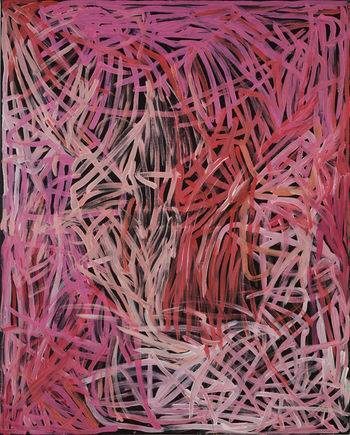
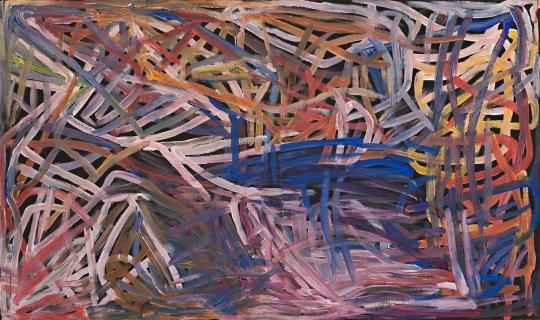
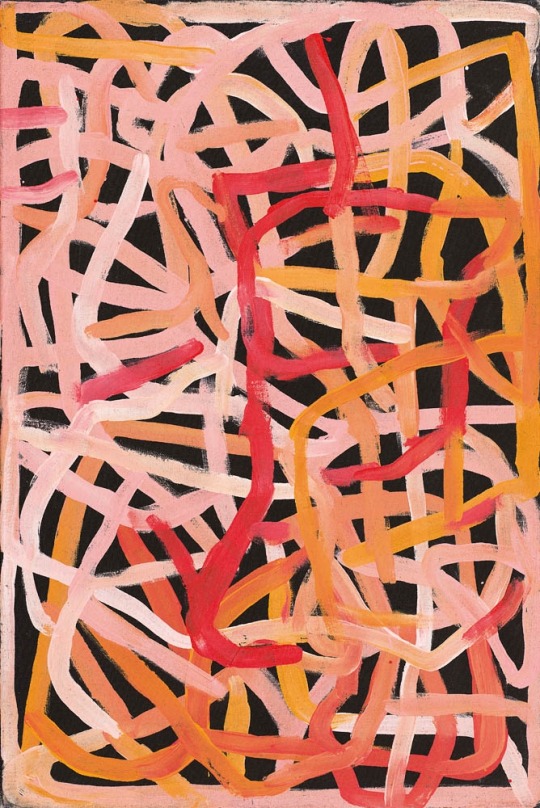
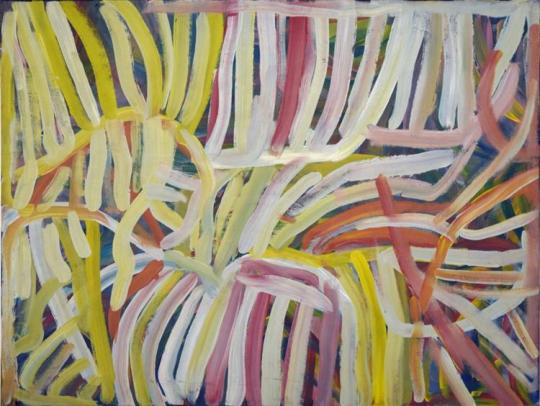
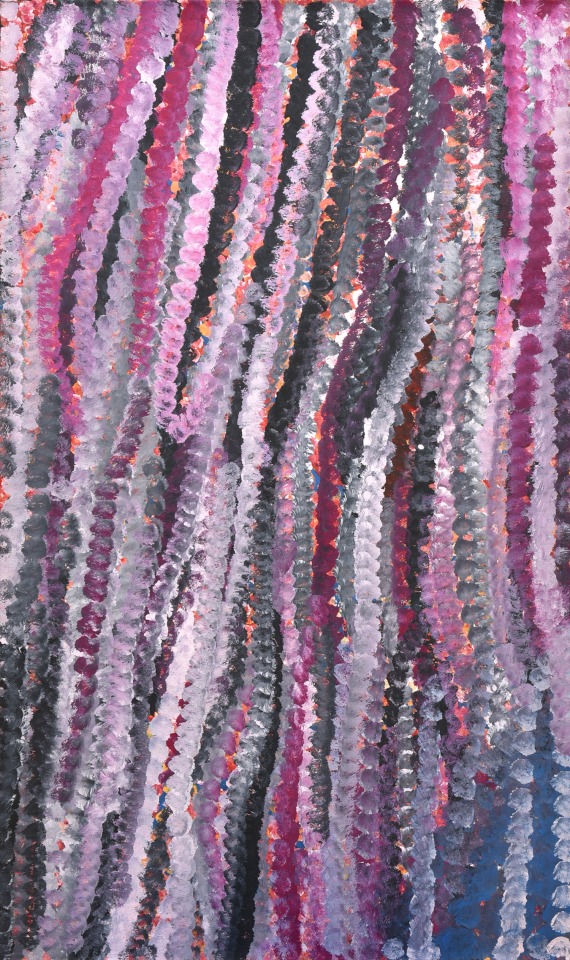

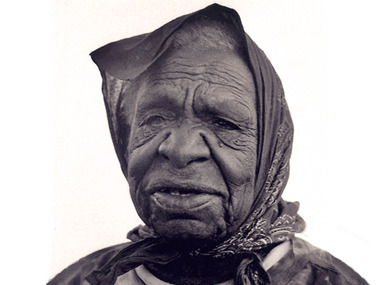
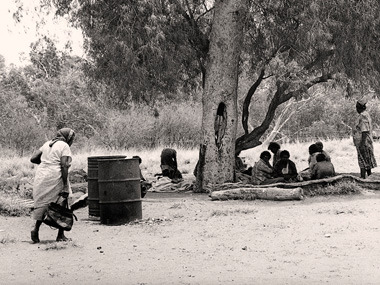
Emily Kame Kngwarreye (1910 – 1996) is considered one of Australias most significant artists. Amazingly, she only began painting with acrylics in her late seventies but in a few short years became an artist of national and international standing.
Emily was the first female painter to emerge from an art movement dominated by men and did so in a way that transformed Aboriginal painting. Employing a variety of styles over the course of her eight-year painting career, she painted her Country and sacred Dreamtime stories in a deeply emotional and expressive manner.
She was born around 1910 at Alhalkere (Soakage Bore), on the edge of the Utopia pastoral station, approximately 250km north-east of Alice Springs. Alhalkere was her fathers Country, and her mothers Country was Alhalpere, just to the east.
Despite being married twice, she had no children of her own but raised her relative Lily Sandover Kngwarreye and her niece Barbara Weir. Both becoming famous artists in their own right. Other nieces that also became famous artists include Gloria Petyarre, Kathleen Petyarre, Ada Bird Petyarre, Violet Petyarre and Nancy Petyarre.
Well before she became one of its most senior contemporary artists, Emily held a unique status within her community of Utopia. Her strong personality and past employment as a stock hand on pastoral properties in the area (at a time when women were only employed for domestic duties), reveals her forceful independence and trailblazing character.
Her age and ceremonial status also made her a senior member of the Anmatyerre language group. She was a senior custodian of cultural sites of her fathers country. She was considered the Boss Woman of the Alatyeye (pencil yam dreaming) and Kame (yam seed dreaming).
Emily started as a traditional ceremonial artist, beginning painting as a young woman as part of her cultural education. An important component of this education was learning the womens ceremonies, which are associated with in-depth knowledge of the Dreamtime stories and of womens social structures.
This knowledge is known as Awelye in Anmatyerre language. Awelye also refers to the intricate designs and symbols associated with womens rituals. These are applied to the womens upper chest, breasts and arms using fingers or brushes dipped into rich desert ochres.
Aboriginal art outside of ceremonial painting began in Utopia in 1977, when batik-making was introduced to women as part of an extended government-funded education program. In 1978, Emily was a founding member of the Utopia Womens Batik Group. In 1988, the Central Australian Aboriginal Media Association (CAAMA) completed its first project with the Utopia Womens Batik Group. This became an exhibition called Utopia - A Picture Story.
From the beginning, Emilys art stood out from the others. Rather than filling her batiks with Aboriginal symbols, she preferred patterns of layered lines and dots that revealed plant, figurative forms and cell like structures. The 88 silk batiks from this first project were acquired by the Holmes a Court Collection in Perth.
In the same year the CAAMA shop initiated The Summer Project, introducing the Utopia womens batik group to the use of acrylic paints on canvas. Among the 81 paintings completed was Emilys first artwork on canvas, Emu Woman.
Inspired by the many Dreamtime stories of which she was a custodian, Emily employed an extraordinary array of styles over the course of her eight-year painting career.
In her early works, Emily preferred the use of an earthy ochre colour palette, reflecting her experience of using natural ochres during ceremonies. Over time she expanded her repertoire to include a dazzling array of colours found in the desert landscape. Colours are significant in her paintings. Yellow, for example, often symbolises the season when the desert earth begins to dry up and the Kame (yam seeds) are ripe.
Her shifting styles also reveal her self-confidence and willingness to experiment with form, pictorial space and artistic conventions. She drew creatively from the geographic landmarks that traverse her Country and the Dreaming stories that define it. Whenever she was asked to explain her paintings, her answer was always the same:
Whole lot, that's the whole lot. Awelye (my Dreamings), Alatyeye (pencil yam), Arkerrthe (mountain devil lizard), Ntange (grass seed), Tingu (a Dreamtime pup), Ankerre (emu), Intekwe (a favorite food of emus, a small plant), Atnwerle (green bean), and Kame (yam seed). That's what I paint; the whole lot.
This is because she chose to present a very broad picture of the land and how it supports the Anmatyerre way of life. Her artworks embrace the whole life story of the Dreamtime, seeds, flowers, wind, sand and everything. Although her works relate to the modern art tradition, this resemblance is purely visual. The emphasis in Emilys paintings is on the spiritual meaning, based in the tradition of her people.
The evolving styles of Emily Kame Kngwarreyes paintings
Emily started to paint in 1988. Her early style featured visible linear tracings following the tracks of the Kame (Yam Dreaming) and animal prints associated with the Emu Dreaming. Fields of fine dots partially obscured symbolic elements.
By 1992 her paintings were so densely packed with layers of dots that her symbolic underpainting was no longer visible.
Another evolution in her painting style occurred when she began to use large brushes. She worked faster, more loosely and on a larger scale. Sometimes dragging the brush while she dotted, producing lines from the sequential dots.
By the mid 1990s she had pioneered a style of Aboriginal painting referred to as dub dub works. They were created by using large brushes which were laden with paint and then pushed into the canvas in such a way that the bristles part and the paint is mixed on the canvas.
Using this technique, she created wildly colourful artworks and her paintings became progressively more abstract. Different artists from Utopia including Polly Ngale and Freddy Purla have subsequently adopted this style.
During the last two years of her life, she used the linear patterns found on womens ceremonial body designs as the primary inspiration for her paintings. The abstracted sequential dots of colour gave way to parallel lines which were much more formally arranged. She had used lines earlier before gradually submerging them under layers of dots. This time, she created simple, bold compositions of parallel lines in strong dark colours.
The above style in turn evolved to looser meandering lines which appear to trace the shapes of the grasses and the roots of the pencil yam as they forge their way through the desert sands.
In 1996 she produced a body of work in which she depicted pencil yam dreaming using a rich ochre colour palette. In this final burst of creative energy, Emily produced a beautiful body of work known as her scribble phase. In these atmospheric paintings, lines and dots were replaced by flowing fields of colour.
https://www.kateowengallery.com/.../Emily-Kame-Kngwarreye...
216 notes
·
View notes
Text
i learned what are the most mysterious places in the world
Marree Man – The fact that there is not a single witness to the creation of the Marree Man speaks to the absolute isolation of central South Australia. Somehow in 1998, one person or a group of people were able to create a 2.6-mile long line drawing of an aboriginal hunter, without being seen. In the midst of barren, arid land in South Australia, the Marree Man is the largest geoglyph and work of art in the world. Cut into the harsh landscape with lines over 115 feet wide and one foot deep, the towering Marree Man is easily visible from space. Thirteen years after the Marree Man was discovered during a flyover, little is known about its origin. Although we may never know the true origin of the Marree Man, it is certainly one of most intriguing modern day mysteries.
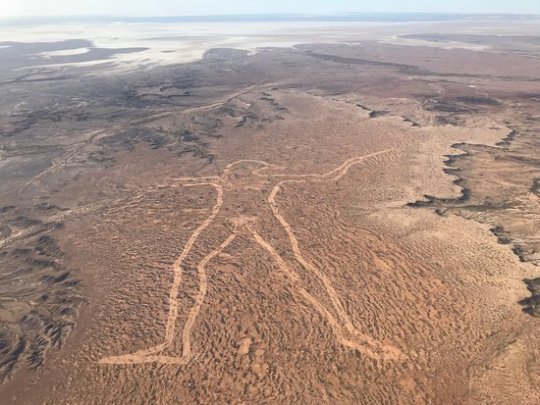
Chocolate Hills – Bohol Island in the Philippines during the dry season, you might notice what looks like thousands of chocolate kisses protruding from the terrain. These mysterious conical mounds are known as the Chocolate Hills. There are approximately 1,268 individual hills, their heights ranging from 100 to 160 feet, though the highest is almost 400 feet high. The hills, which are almost all symmetrical, consist of grass-covered limestone and turn brown during the dry season. Despite the abundance of hills, it is unclear how they were formed. There are multiple geological explanations ranging from oceanic volcano activity to limestone weathering. Numerous legends and tales also exist to explain the Chocolate Hills.
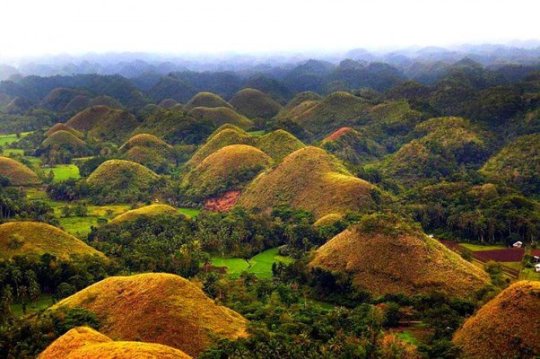
Giants Nest – In 1949 a geologist named Vadim Kolpakov discovered a large mound of limestone in the north of the Irkutsk region in southeastern Siberia. The cone is curiously shaped with a crater at the top and a small mound in the center. The mound is about 40 meters high and 100 meters across at the base. The smaller mound at the top is about 12 meters high. The crater was named Patomskiy, after a nearby river, but local residents call it “the Fiery Eagle’s Nest”. Since the discovery of the crater, there have been many theories as to what could have created it. For a long time it was believed to be a meteorite impact structure. Some linked it to the Tunguska meteorite, whose remains have never been discovered. But the crater does not resemble any other known meteorite site. Even now, the origin of the crater is not discovered.
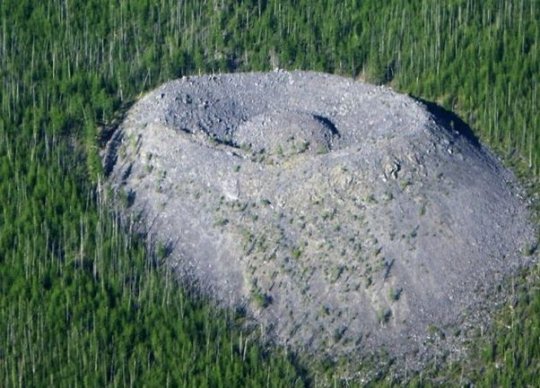
Richat Structure – In the midst of vast, vacant Sahara desert, just outside of Ouadane, Mauritania, lies a 30-mile wide geological oddity known the Richat Structure, sometimes called the “Eye of Africa.” From space, this natural curiosity forms a distinct and unmistakable bull’s-eye that once served as a geographical landmark for early astronauts as they passed over the Sahara. Once thought to be an impact crater due to its circularity, the unusual formation is now widely believed to have been caused by the erosion of a geological dome formed by pressure from a bulb of molten magma below.
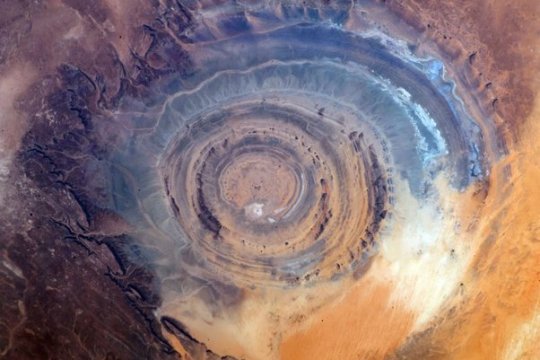
Plain of Jars – The Plain of Jars is a collection of large stone jars interspersed throughout the Xieng Khouang plain in the Lao Highlands. The stone structures are mostly made of sedimentary rock and, ranging from 3 to 10 feet in height, each can weigh up to 14 tons. To date, the origin of the jars is unknown, though archaeologists believe that they were originally used between 1,500 and 2,000 years ago. Many researchers have theorized that the jars may have once served as funerals urns or food storage. As local Laotian legend would have it, the jars were created by Khun Cheung, an ancient king of giants who lived in the highlands. It is said that Cheung, after fighting a long and victorious battle, created the jars in order to brew huge amounts of celebratory lao lao rice wine.
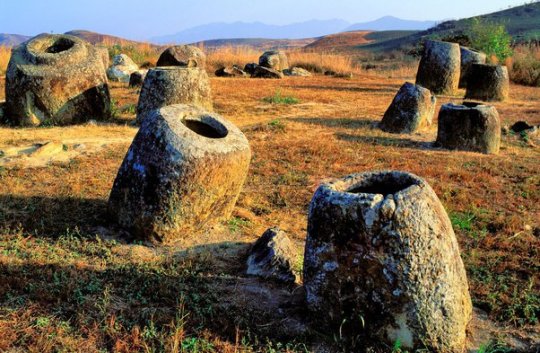
Giant’s Grave of Coddu Vecchiu – Giant’s or Tomba Dei giganti, are megalithic gallery graves that were used as public tombs during the Bronze Age. The massive gravestones were built by the Nuragic civilization, which existed in Sardinia from the 2nd millennium BCE. to the 2nd century CE. Despite the imaginative name, the sites were not the burial site of any giant; they were giant community burial chambers. Though we know the tombs had a funerary purpose, more questions remain. Little is known about the rituals or traditional beliefs that motivated their construction. Were they mass graves? Were they built to facilitate the journey into the afterlife? Since their existence has yet to be justified by scientific research, they have been credited to the supernatural, which has only increased their mystery. Legend also claims that yes, indeed, these were the tombs of powerful giants.
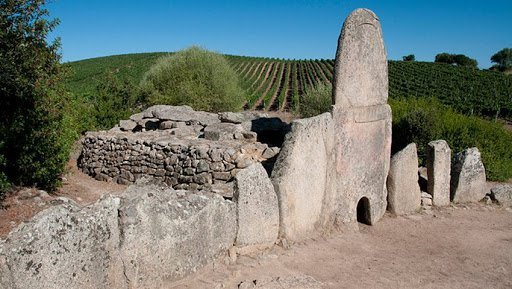
Zone of Silence – Pilot Francisco Sarabia was flying over a patch of desert land in Mexico when his instruments started to act increasingly odd. The man had to make an emergency landing in the middle of nowhere. Little did he know that this "nowhere" would be later dubbed "The Zone of Silence.” Weird radio silence isn't the only oddity of the creepy Zone. Like, what’s that weird trio that locals keep meeting in the Zone? They’re two men and a woman. Every time people see them, they’re wearing bizarre clothing that isn't suitable for a journey in the desert whatsoever. On top of all that, the Zone of Silence is known as a 50 km patch of deserted land where meteorites come crashing down on an eerily regular basis. On July 11, 1970, the US launched an ATHENA rocket from the Air Force base in Green River, Utah. The rocket was supposed to land somewhere in the area of White Sands in New Mexico. Instead, it went off course and, as if being pulled by some external force, crashed right in the heart of the Zone of Silence.
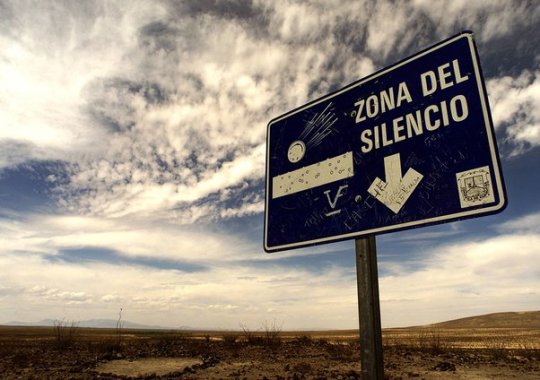
Michigan Triangle – Stretching from Ludington to Benton Harbor, Michigan and to Manitowoc, Wisconsin, the Lake Michigan Triangle has inspired numerous accounts of activity that are difficult to explain by rational thought. The mystery began in 1891, when a schooner named the Thomas Hume set off across the Lake to pick up lumber. Almost overnight in a torrent of wind, the Thomas Hume disappeared along with its crew of seven sailors. The wooden boat was never found. After the turn of the century, strange events happened at steady intervals. Of the more mysterious is the case of the Rosa Belle. In 1921 eleven people inside the ship, who were all members of the Benton Harbor House of David, disappeared and their ship was found overturned and floating in Lake Michigan. While it appeared that the ship had been damaged in a collision, no other ship had reported an accident and no other remains had been found.
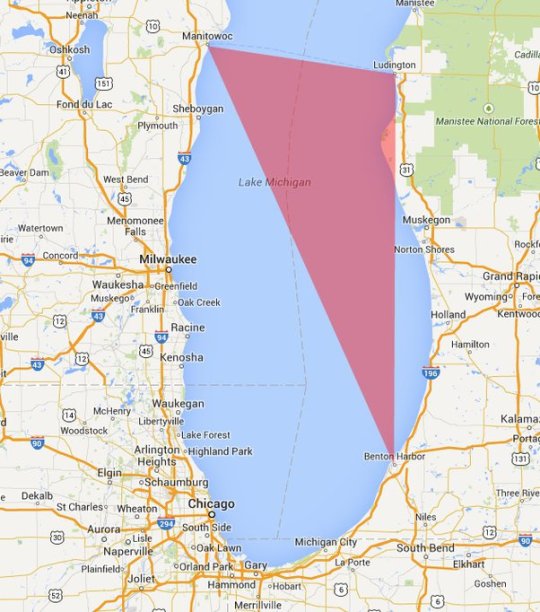
Alaska Triangle – The Alaska Triangle is a place in the untouched wilderness where mystery lingers and people go missing at a very high rate. The area began attracting public attention in October 1972, when a small, private plane carrying U.S. House Majority Leader Hale Boggs, Alaska Congressman Nick Begich seemingly vanished into thin air. For more than a month, 50 civilian planes and 40 military aircraft plus dozens of boats, covered a search area of 32,000 square miles, but no trace of the plane, the men, wreckage or debris were ever found. Afterward, more planes went down, hikers went missing, and Alaskan residents and tourists seemed to vanish into thin air. In fact, since 1988, more than 16,000 people have disappeared in the Alaska Triangle, with a missing person rate at more than twice the national average. These disappearances are blamed on everything from severe weather to aliens, to swirling energy vortexes, to an evil shape-shifting demon of Tlingit Indian lore called Kushtaka, with no scientific explanation to the disappearances till today.

The Initiation Well – The Initiation well is 88 feet deep well located on the land of Quinta da Regaleira. Actually, it was used for ceremonial purposes. There is another small well near this well. Both these wells are connected by tunnels. The larger well contains a 27-meter spiral staircase with several small landings and the smaller well contains straight stairs that connect a series of ring-shaped floors to one another. The smaller well is also called the 'Unfinished Well'. The depth of this larger well is equal to the four-storey building, which becomes narrower on going closer to the ground. It is believed that there is some kind of light comes out from the well inside the ground and comes outwards. Surprisingly, there is no system of light inside this well, then where from this light comes, it is the secret. Anyone who comes to visit here, always raises the question of where the light comes from inside the well? Till today this secret is unsolved.
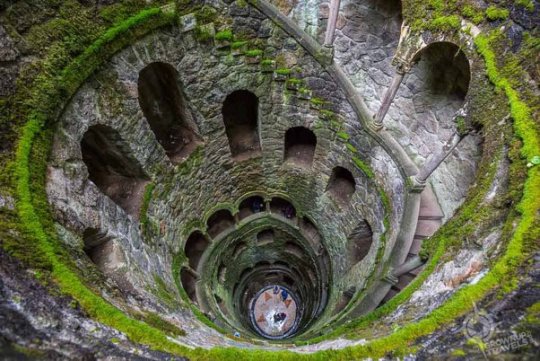
(Image Source : Google)
Thanks for Reading.
694 notes
·
View notes
Text
thank you for tagging me @ivymarquis ! i debated between this, the regency fic (fleshed out), or one of the other Price fics i'm working on (home from college for the summer and seducing hot older neighbour Price whomst you had a crush on since sixteen (aka daddy issues, the playbook), DomPrice, etc), but i think the Soap fic will probably be finished before all of those. so, here is the baby trap piece with Soap.
nothing smutty but this def captures their odd, imbalanced dynamic perfectly, i think:
“And you have no cellphone? No satellite phone?”
“Ye can check it—” he makes a flippant motion toward the glove box in front of you. “Deader than ever.”
You hesitate only briefly. Long enough to level him with a searching look that yields no results (every expression hidden behind a thick, unruly forest of overgrown hair jutting out to his Adam's apple) before you reach for the compartment, gingerly pulling it open, and—
Sometimes, things get overlooked by their surroundings. Swallowed in the vacuum. Blending seamlessly into the muddle, the commotion. Or hidden. Can you spot the mountain lion in this tumble of rock and bush?
This isn't like that.
It sits on top of a manila folder. Sleek black and cold silver. You're not terribly well-versed in guns—the extent of your knowledge stemming mostly from formulaic crime shows aired late at night; CSI, NCIS, Criminal Minds—but you recognise this one instantly. Some sort of handgun. Police issued, you think. It's bigger than you'd expected. Looks heavier, too.
Your heart stutters. The air galloping out of your lungs in a stammering rush.
He makes a noise, soft and nonchalant, as if keeping handguns in the glove box of his old, burnt umbre truck is perfectly normal.
“Fer protection,” he mumbles. You catch the jerk of his chin in your periphery. “Forgot I had it in here. Been usin’ the rifle for huntin’ mostly. Or the shotgun.”
Three guns. You swallow. “Why—” your voice comes out in a brittle whisper. You clear your throat. Pretend it helps, that you don't feel as vulnerable as you sound right now. “Why, um, why do you need three?”
“Not fae around ‘ere, are ye?” He echoes your words from earlier with a wry twist of his mouth, eyes slanting in the sunlight. “Tha’,” he takes his hand off your thigh to jab his finger at the handgun. “Is fer wolverines.” His index finger falls, his thumb juts out. He jerks it over his shoulder. “Tha’ is fer huntin’. The shotgun back home is fer bears.”
You try to move out of the way when his hand falls back to your thigh, but the pain radiating up your leg immobilizes you. There's not much you can do in this situation but endure.
Military. Wounded in action. Three guns. Touchy.
You're not sure what to think. It would be easier if you couldn't.
“What do you hunt?” You ask instead, glancing out the window to the barren landscape rolling out around you. There doesn't seem to be much in the jagged hills, towering mountains.
“Gettin’ hungry? Donnae worry, doe. Go’ tha’ pesky hare I was tryin’ tae shoot on the ledge fer dinner tonight.”
It's not much of a comfort. The idea of being injured—by accident, he claims—to such an extent over a rabbit makes you feel a little sick.
“That's it?”
“I can make a mean steak outta anythin’. Stews fer tougher meat. Fish, too—whitefish, arctic grayling, and lake trout. Learned how tae make a nasty fishfry from the locals in Nahanni Butte. Bannock, too. Got berries ‘round ma cabin. Caribou, Moose. Taste better in tacos or burgers. Mountain goat, Dall’s sheep. Been eatin’ better ‘ere than ah did at home.”
“And you're—just allowed to hunt them?” The website advised of a permit through some special outfit needed to hunt when you requested your pass into the park. Said that only aboriginals were allowed to do so. “You're not—”
“Aye,” he cuts you off with a small nod. “No huntin’ in the park. But. We're not in the park anymore.”
“Where are we?” You ask again, firmer this time.
“I told ye. Nearly home.”
“And where is home?”
The way he sucks his teeth makes you recoil slightly. Wet. Irritated. As if he's tired of this conversation already.
“Close.”
You don't let his flat tone deter you. “Are we—are we still in the Northwest Territories?”
“Thereabouts.”
It's not an answer. It doesn't reassure you in the slightest.
You open your mouth to say so, words curling on your tongue when he jerks his chin toward the handgun, brow furrowed.
“Thought ye wanted tae check on the satellite phone.”
His tone is severe. A growl curdling the ends, pitching it down, down. Displeasure, irritation, blooms in the gnarled petals of witch hazel when he narrows them into slits.
#baby trap anthology#soap x reader: baby trap#wips#wip wednesday#my love for nwt and national parks is almost smothering#but i still managed to throw so many inaccuracies in this fic lmao#and the idea of an auntie and uncle teaching Soap how to fry fish and make bannock had me in absolute stitches lmao
134 notes
·
View notes
Text
The Wandjinas [Australian Aboriginal mythology]!

In the belief system of the native Aboriginal people of Kimberley, Western Australia, the peculiar rock paintings called ‘Wandjina’ play a significant cultural role. The depicted spirits have a very distinct appearance with a mouthless face, large eyes and their signature headdress.
Long before humans existed, the Wandjinas populated the earth along with Ungud, a divine being. These mysterious spirits are each responsible for the creation of a specific feature of nature and the world we live in.
And so these beings wandered around the world, shaping it into the landscape we can see today. When their work was done, each Wandjina wandered into a cave and died, transforming into the painting. This is actually an important distinction: though I’m using the word ‘painting’ in this article, traditional Aboriginal belief holds that the Wandjinas were never actually painted by someone. Instead, they appeared on the stone walls as the reincarnation of the Wandjina’s living form.
As such, it is important that these paintings are renewed every year (this typically happens at the end of the dry season), for if a painting is lost then the spirit of that Wandjina will die. If the Wandjinas are lost or destroyed, the world would end and there would be no more rain; the Earth would become a barren desert landscape and the pillars that hold up the heavens will break.
Renewing a painting of a female Wandjina in particular will replenish the fertility of the people, which supposedly causes an increase in births. It is actually unknown why Wandjina are always depicted without mouths, but this is an important characteristic as native people claim it would be unthinkable to add one. Anthropologists have speculated that this symbolizes the spirits’ life-giving nature: they always create, and never consume.
Sources: Blundell, V. J., 1974, The Wandjina Cave Paintings of Northwest Australia, Arctic Anthropology, 11, pp. 213-223. Cotterell, A. et al., 1999, Encyclopedie van de Wereld Mythologie, Parragon, 320 pp. (image 1: Wandjinas near the Barnett River. Image source: Graeme Churchard)
60 notes
·
View notes
Text
Recent studies led by the University of Melbourne have revealed that the Palawa people's ancient land stewardship techniques have profoundly shaped the landscape of western Lutruwita, within the traditional territories located in Tasmania. The research, published in Quaternary Science Reviews, presents paleoecological data indicating significant shifts in the vegetation of Tasmania's cool temperate rainforests, correlating with periods prior to and following human settlement. This research was undertaken with the express consent and support of the Lutruwitan Aboriginal community.
Continue Reading.
108 notes
·
View notes
Text
Mangroves. Estuaries. Shorelines where land meets water. Fluidity and porousness of boundaries. Imposition of imperial, colonial, European property law and the “fiction” of solid borders. Profit extraction from property, the “legal magic” of creating permanent borders, and the destruction of coastal forest-worlds.
---
[T]his tropical coastal ecology is a site of continual refiguration: neither sea nor land, neither river nor sea, bearing neither salty nor fresh water [...]. The mangrove has been prone to confused definitions, [...] also a complex coastal ecosystem in itself. With these hybrid conditions of “belonging,” the mangrove lends itself to helping us think through the present-day schematic of Euro-American crises [...]. Its polymorphous personality as a sediment-carrier, land-builder, defender of numerous life forms [...] renders the mangrove a fascinating study in the biopolitics of selfhood. [...] The Sundarbans covers an area of 10,000 square kilometers of intertidal zones between parts of southwestern Bangladesh and the state of West Bengal in India. The largest mangrove forest in the world [...]. As a landscape, the Sundarbans is marked by unfixity, since its intertidal nature places it between appearance and disappearance -- with islands being submerged overnight. [...] [T]heir porous quality does not allow for clear border-making. In reading [...] satellite image[ry] of the Sundarbans, produced by what is said to be “the most stable, best characterized Earth observation instrument ever placed in orbit,” we are met with the trembling instability of borders. [...] [H]ere the coastline becomes indiscernible as a single entity. The legal vexations of such amphibious and obtuse terrain become pronounced in sea-rights cases, wherein border-making becomes the necessity of tenure. Forming rulings over such zones lays legality prone to paradox. In the Blue Mud Bay case, heard by the High Court of Australia in 2008, a legal body was called upon to make a determination regarding the shifting geography of a mangrove coastal region. In the final ruling the aboriginal Yolgnu claimants were successful, with the court ruling that the column of tidal water lying above land should be regarded no differently from the land itself. Thus the court’s attempt to encompass Dholupuyngu cosmology and “aqueography” occasioned a legal magic transforming water flow into the fixity of “land.” [...] The mangrove line is, hence, one of sedimentary reclamation rather than clear political divisions of terra firma. In mangrove zones, human determinations become ghosts.
Text by: Natasha Ginwala and Vivian Ziherl. “Sensing Grounds: Mangroves, Unauthentic Belonging, Extra-Territoriality.” e-flux Journal Issue #45. May 2013.
---
Traveling through Bengal in the eighteenth century, [...] [travelers] saw a highly sophisticated water-based economy -- the blessing of rivers [...]. The rivers were not just channels of water; they carried a thriving trade, transporting people and goods from one part of the delta to another. [...] Bengal’s essential character as a fluid landscape was changed during the colonial times through legal interventions that were aimed at stabilizing lands and waters, at creating permanent boundaries between them, and at privileging land over water, in a land of shifting river courses, inundated irrigation, and river-based life. Such a separation of land and water was made possible not just by physical constructions but first and foremost by engineering a legal framework. [...] BADA, which stands for the Bengal Alluvion and Diluvion Act, a law passed by the colonial British rulers in 1825 [...]. Nature here represents a borderless world, or at best one in which borders are not fixed lines on the ground demarcating a territory, but are negotiated spaces or zones. Such “liminal spaces” comprise “not [only] lines of separation but zones of interaction…transformation, transgression, and possibility” [...]. Current boundaries of land and water are as much products of history as nature and the colonial rule of Bengal played a key role in changing the ideas and valuations of both. [...] [R]ivers do not always flow along a certain route [...]. The laws that the colonial British brought to Bengal, however, were founded upon the thinking of land as being fixed in place. [...] To entrench the system, the Permanent Settlement of 1793 created zamindars (or landlords) “in perpetuity” -- meaning for good. The system was aimed at reducing the complexities of revenue collection due to erratically shifting lands and unpredictable harvests in a monsoon-dependent area [...]. From a riverine community, within a hundred years, Bengal was transformed into a land-based community.
Text by: Kuntala Lahiri-Dutt. “Commodified Land, Dangerous Water: Colonial Perceptions of Riverine Bengal.” RCC Perspectives, no. 3, 17-22. 2014.
---
[A]t the shore, where the boundary between land and water is so often muddied [...] terrestrial principles of Western private property regimes feel like fictions [...]. Shorelines, indeed, do much to trouble the neat boundaries, borders […] of the colonial imaginary […]. And so thinking about shallows necessitates attention to the multiplicity of water, and the ways that tides, rivers, storm clouds, tide pools, and aquifers converse with the ocean [...]. For Kanaka Maoli, the muliwai, or estuary, best theorizes shoreline dynamics: It is not only where land and water mix, but also where different kinds of waters mix. Sea and river water mingle together to produce the brackish conditions that tenderly support certain plant and aquatic lives. [...] As Philipp Schorch and Noelle M.K.Y. Kahanu explain, the muliwai ebbs and flows with the tide, changing shape and form daily and seasonally. In metaphorical terms, the muliwai is a location and state of dissonance [...], but it is not “a space in between,” rather, it is its own space, a territory unique in each circumstance, depending the size and strength or a recent hard rain. […] [T]he muliwai [...] as a conditional state [...] undoes territorial logics. [...] It is not a space of exception. Rather, it is where we are reminded that places are never fixed or pure or static. Chamorro poet Craig Santos Perez reminds us in his critique of US territorialism that “territorialities are shifting currents, not irreducible elements.” If fixity and containment limit, by design, how futures might be imagined beyond property, then the muliwai envisions decolonial spaces as ones of tenderness, care, and interdependence. [...] Because water has the potential to trouble the boundaries of humanness, it may furthermore push us to think through […] categorical differences […], to consider the colonial mechanisms that produced hierarchies of bodies to begin with [...].
Text by: Hi’ilei Julia Hobart. “On Oceanic Fugitivity.” Ways of Water series, Items, Social Science Research Council. Published online 29 September 2020.
#abolition#ecology#landscape#imperial#colonial#tidalectics#caribbean#archipelagic thinking#wetlands#mangroves#estuaries shoals swamps deltas etc#indigenous#ecologies#geographic imaginaries#carceral geography
169 notes
·
View notes